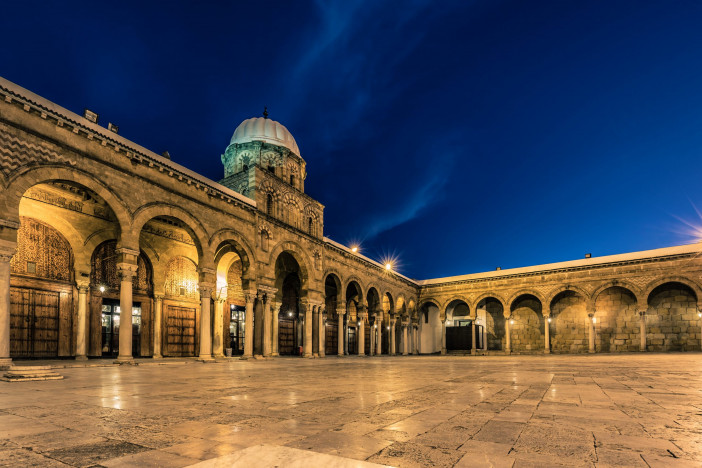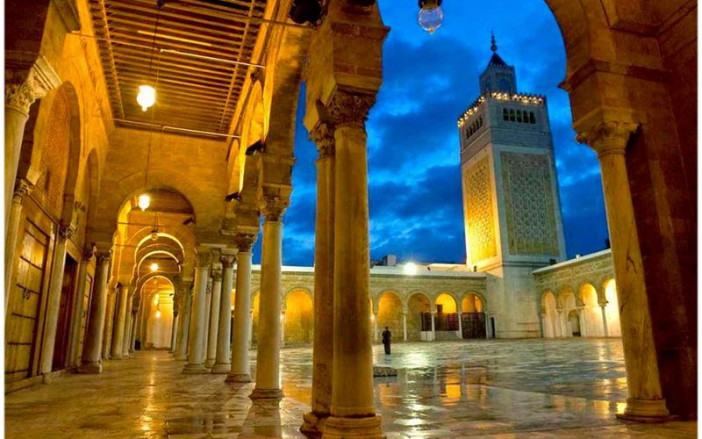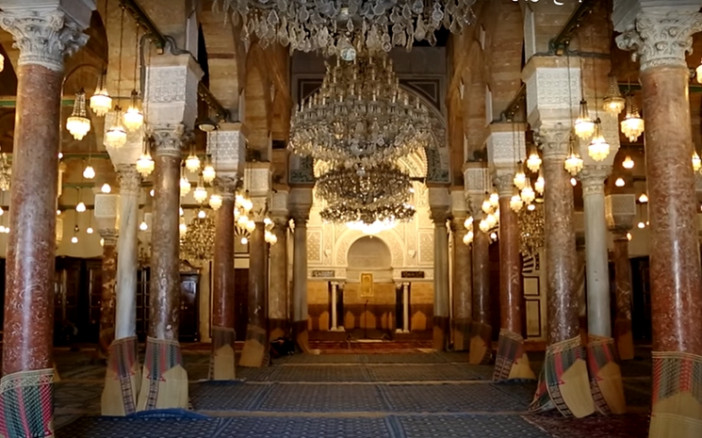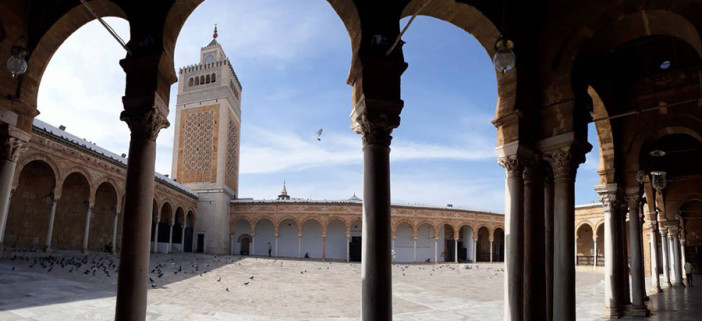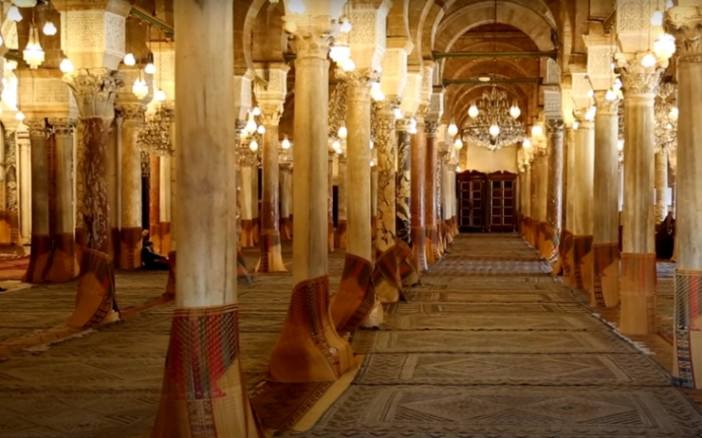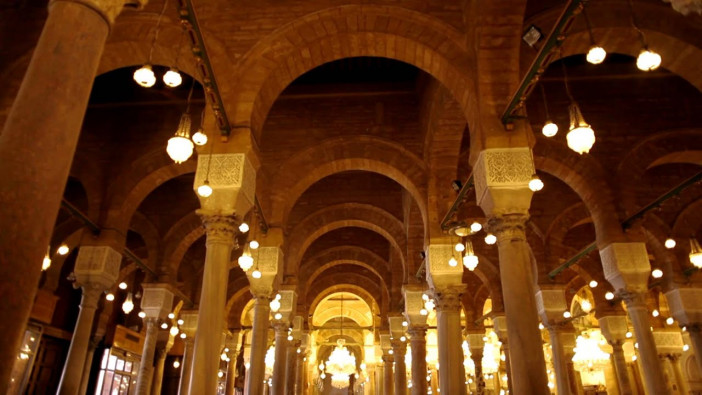Al-Zaytuna Mosque
History
There are still some pieces of wall and a corner tower in rough stone dating from the 3rd/ 9th century. It has a rich and complicated history. Some sources attribute this to Abdullah ibn al-Habhabhab (116/734), but there is evidence that the builder was Hassan ibn Nu'man.
Investigations have confirmed that the Great Mosque of Tunis was built on the remains of a Christian basilica, giving weight to the legend related by Ibn Abi Dinar. The mosque was fully rebuilt by the Aghlabid emirs in 248 / 863. An inscription at the base of the mihrab dome indicates that Fathallah, a slave of the Abbasid caliph al-Nasir, was in charge of the work.
Urban and Architectural
The Zaytuna building was a major defence station facing the sea. Two control towers on the north-eastern and south-eastern corners remain intact.
The mosque of Zaytuna is of the same type as those of Cordoba and Kairouan; an extensive courtyard leading to a stone hall with a roof supported by wooden beams. The roof extends on a surface of 1344 m2. About 160 antique columns and capitals divide the mosque into 15 naves and 6 bays. It is clear that the antique material originates from the ruins of Carthage.
The centre nave and the transverse nave of the transept are larger than the others (4.80 m instead of 3 m). They intersect at right angles to a mihrab, forming a T-shape. The mihrab is equipped with a fluted cupola and an octagonal drum with a square base. It has an inscription attributed to the Abbasid caliph al-Mustin.
A round gallery was added to the trapezoid court in the AH 4th / AD 10th century. Consequently, the narthex has masked the kufic inscription of the AH 3rd / AD 9th century that is still on the façade behind the gallery. The entry dome is heavily ornamented, with alternating rows of ochre stone and red brick. The profusion of niches covering the square base and the octagonal drum is characteristic of the Fatimid style.
Description
The square minaret stands from the north-western corner of the courtyard. Built in 1894, it is 43 m tall and imitates the decoration of the Almohad minaret of the Kasbah mosque with its limestone bracelet on an ochre sandstone background.
Twelve doors open onto the souks. Two are noteworthy: the door of the imam, on the qibla wall, framed with a Roman lintel and sculpted marble pillars; and a western door with a date inscription. The facade has a courtyard with colonnades and Hafsid capitals.
References
https://carthagemagazine.com/the-great-mosque-of-ez-zitouna/
https://islamicart.museumwnf.org/database_item.php?id=monument;isl;tn;mon01;1;en
https://en.wikipedia.org/wiki/Al-Zaytuna_Mosque
Details
Location
30 Road Jamaa Ezzitouna, Tunis Tunisia
Worshippers
2000
Owners
The Aghlabid amir Abu Ibrahim Ahmad and the Abbasid caliph al-Must‘in Billah
Year of Build
863
Area
5000
Drawings
Map
History
There are still some pieces of wall and a corner tower in rough stone dating from the 3rd/ 9th century. It has a rich and complicated history. Some sources attribute this to Abdullah ibn al-Habhabhab (116/734), but there is evidence that the builder was Hassan ibn Nu'man.
Investigations have confirmed that the Great Mosque of Tunis was built on the remains of a Christian basilica, giving weight to the legend related by Ibn Abi Dinar. The mosque was fully rebuilt by the Aghlabid emirs in 248 / 863. An inscription at the base of the mihrab dome indicates that Fathallah, a slave of the Abbasid caliph al-Nasir, was in charge of the work.
Urban and Architectural
The Zaytuna building was a major defence station facing the sea. Two control towers on the north-eastern and south-eastern corners remain intact.
The mosque of Zaytuna is of the same type as those of Cordoba and Kairouan; an extensive courtyard leading to a stone hall with a roof supported by wooden beams. The roof extends on a surface of 1344 m2. About 160 antique columns and capitals divide the mosque into 15 naves and 6 bays. It is clear that the antique material originates from the ruins of Carthage.
The centre nave and the transverse nave of the transept are larger than the others (4.80 m instead of 3 m). They intersect at right angles to a mihrab, forming a T-shape. The mihrab is equipped with a fluted cupola and an octagonal drum with a square base. It has an inscription attributed to the Abbasid caliph al-Mustin.
A round gallery was added to the trapezoid court in the AH 4th / AD 10th century. Consequently, the narthex has masked the kufic inscription of the AH 3rd / AD 9th century that is still on the façade behind the gallery. The entry dome is heavily ornamented, with alternating rows of ochre stone and red brick. The profusion of niches covering the square base and the octagonal drum is characteristic of the Fatimid style.
Description
The square minaret stands from the north-western corner of the courtyard. Built in 1894, it is 43 m tall and imitates the decoration of the Almohad minaret of the Kasbah mosque with its limestone bracelet on an ochre sandstone background.
Twelve doors open onto the souks. Two are noteworthy: the door of the imam, on the qibla wall, framed with a Roman lintel and sculpted marble pillars; and a western door with a date inscription. The facade has a courtyard with colonnades and Hafsid capitals.


